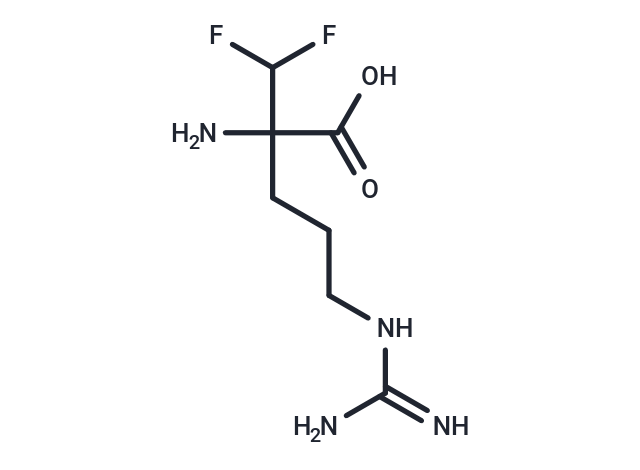 Your shopping cart is currently empty
Your shopping cart is currently empty

α-(difluoromethyl)-DL-Arginine (RMI 71897) is an enzyma-activated, irreversible inhibitor of arginine decarboxylase for E. coli (Ki = 800 μM), Pseudomonas aeruginosa, and Klebsiella pneumoniae. At 0.01 mM, it has been shown to prevent osmotic stress-induced increases in arginine decarboxylase activity and putrescine synthesis in oat leaf cells. When combined with a variety of polyamine analogues, α-(difluoromethyl)-DL-Arginine inhibited the growth of Trypanosoma Crui in mammalian host cells at a minimum concentration of 10 mM and prevented the growth of Trypanosoma Crui in T-cell receptor alpha-deficient mouse models.

| Pack Size | Price | USA Warehouse | Global Warehouse | Quantity |
|---|---|---|---|---|
| 1 mg | $68 | In Stock | In Stock | |
| 5 mg | $159 | In Stock | In Stock | |
| 10 mg | $233 | In Stock | In Stock | |
| 25 mg | $392 | In Stock | In Stock | |
| 50 mg | $582 | In Stock | In Stock |
| Description | α-(difluoromethyl)-DL-Arginine (RMI 71897) is an enzyma-activated, irreversible inhibitor of arginine decarboxylase for E. coli (Ki = 800 μM), Pseudomonas aeruginosa, and Klebsiella pneumoniae. At 0.01 mM, it has been shown to prevent osmotic stress-induced increases in arginine decarboxylase activity and putrescine synthesis in oat leaf cells. When combined with a variety of polyamine analogues, α-(difluoromethyl)-DL-Arginine inhibited the growth of Trypanosoma Crui in mammalian host cells at a minimum concentration of 10 mM and prevented the growth of Trypanosoma Crui in T-cell receptor alpha-deficient mouse models. |
| Targets&IC50 | arginine decarboxylase (E. coli):800 μM (Ki) |
| Synonyms | α-(difluoromethyl)-DL-Arginine, RMI 71897, DFMA |
| Molecular Weight | 224.21 |
| Formula | C7H14F2N4O2 |
| Cas No. | 69955-43-7 |
| Smiles | C(CCCNC(=N)N)(C(F)F)(C(O)=O)N |
| Relative Density. | 1.53 g/cm3 (Predicted) |
| Color | White |
| Appearance | Solid |
| Storage | keep away from moisture | Pure form: -20°C for 3 years | In solvent: -80°C for 1 year | Shipping with blue ice/Shipping at ambient temperature. | |||||||||||||||||||||||||
| Solubility Information | PBS (pH 7.2): 5 mg/mL (22.3 mM), Sonication is recommended. DMSO: 7.7 mg/mL (34.34 mM), Sonication is recommended. | |||||||||||||||||||||||||
| In Vivo Formulation | PBS: 4.5 mg/mL (20.07 mM), Solution. Please add the solvents sequentially, clarifying the solution as much as possible before adding the next one. Dissolve by heating and/or sonication if necessary. Working solution is recommended to be prepared and used immediately. The formulation provided above is for reference purposes only. In vivo formulations may vary and should be modified based on specific experimental conditions. | |||||||||||||||||||||||||
Solution Preparation Table | ||||||||||||||||||||||||||
PBS (pH 7.2)/DMSO
| ||||||||||||||||||||||||||
| Size | Quantity | Unit Price | Amount | Operation |
|---|

Copyright © 2015-2026 TargetMol Chemicals Inc. All Rights Reserved.